(完整版)外研版新课标三起点小学英语语法及习题.docx
- 格式:docx
- 大小:21.59 KB
- 文档页数:14
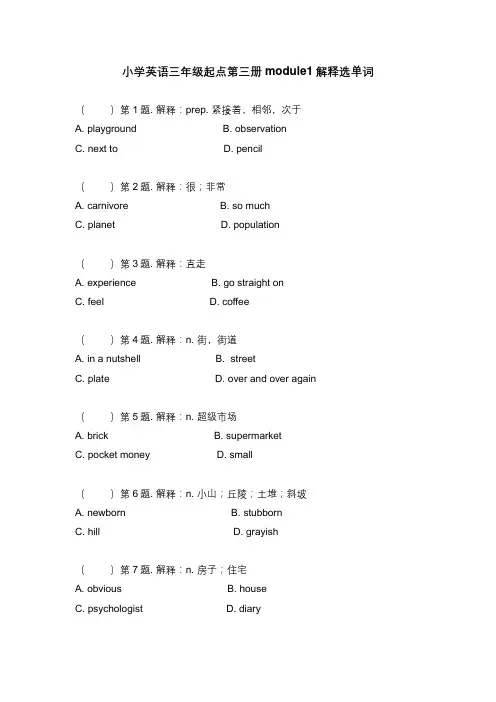
小学英语三年级起点第三册module1解释选单词()第1题. 解释:prep. 紧接着,相邻,次于A. playgroundB. observationC. next toD. pencil()第2题. 解释:很;非常A. carnivoreB. so muchC. planetD. population()第3题. 解释:直走A. experienceB. go straight onC. feelD. coffee()第4题. 解释:n. 街,街道A. in a nutshellB. streetC. plateD. over and over again()第5题. 解释:n. 超级市场A. brickB. supermarketC. pocket moneyD. small()第6题. 解释:n. 小山;丘陵;土堆;斜坡A. newbornB. stubbornC. hillD. grayish()第7题. 解释:n. 房子;住宅A. obviousB. houseC. psychologistD. diary()第8题. 解释:n. 车站;电台A. glassB. outbreakC. stationD. arrangement()第9题. 解释:a. 一直的,直的ad. 一直地,直地A. hard-workingB. straightC. atmosphereD. heretic()第10题. 解释:n. 正当的要求;权利;右边;对;正确;公正a. 对;正确的;右;右边的;正当的;妥当的;正常的;健康的ad. 正确地;恰恰;完全地;向右A. let outB. gumC. godD. right小学英语三年级起点第三册module2解释选单词()第1题. 解释:v. 读;朗读(过去式:read,过去分词:read)A. masterpieceB. readC. suitcaseD. lead()第2题. 解释:n. 中国A. bring upB. ThanksgivingC. packagingD. China()第3题. 解释:n. 跑步;运转;赛跑;流出A. snowstormB. runningC. MiamiD. weekday()第4题. 解释:听A. overB. listen toC. environmentalistD. ski()第5题. 解释:child的复数形式n. 孩子,儿童A. childrenB. orC. nitrogenD. Switzerland()第6题. 解释:vt. 拿;拿走;做;服用;乘坐;花费(过去式took)n. 连续拍摄的场景、镜头A. remainB. takeC. cherishD. man()第7题. 解释:a.&pron. 这些A. theseB. realityC. serviceD. drily()第8题. 解释:责备;与…谈话A. fireworkB. talk toC. uncannyD. rattle()第9题. 解释:vi. 听A. varyingB. listenC. in many waysD. solely()第10题. 解释:v. 照相A. tiringB. combinationC. green with envyD. take pictures小学英语三年级起点第三册Module3解释选单词()第1题. 解释:a. (饥)饿的A. hungryB. check overC. auditoryD. spray()第2题. 解释:n. (一)排,(一)行v. 划船 (过去式 rowed) A. crystal B. surfboardC. primaryD. row()第3题. 解释:a. 有趣的;有意思的A. interestingB. eyebrowC. flickD. get along()第4题. 解释:龙船,龙舟A. dragon boatB. tillC. social workerD. tool()第5题. 解释:我也是,我也一样A. companyB. Me tooC. overlookD. glue stick()第6题. 解释:v. 唱,唱歌A. singB. stadiumC. for the first timeD. crayon holder()第7题. 解释:n. 龙A. acquisitionB. addC. dragonD. ow()第8题. 解释:n. 象棋,国际象棋A. honeyB. chessC. NigeriaD. pop()第9题. 解释:n. 时钟A. alienB. forwardsC. clockD. size()第10题. 解释:豆奶,豆浆A. soya milkB. make a basketC. generalD. rotten小学英语三年级起点第三册Module4解释选单词()第1题. 解释:n. 冰;冰块A. alongB. leave forC. iceD. look ahead()第2题. 解释:n. 食物,食品A. pineB. clockC. foodD. freeze()第3题. 解释:n. 土豆,马铃薯A. shoreB. militaryC. wonderlandD. potato()第4题. 解释:n. 汁、液A. broadcastB. lifelongC. juiceD. fruit pie()第5题. 解释:n. 蛋;卵A. north-westB. South PoleC. eggD. cylinder()第6题. 解释:n. 快餐A. fast foodB. talk ofC. grassD. here you are()第7题. 解释:n. 花A. votingB. firearmC. flowerD. licence()第8题. 解释:n. 西红柿,番茄A. woundB. tomatoC. e-mailD. be angry with()第9题. 解释:a. 一些,若干;有些;某一pron. 若干,一些A. some B. lay outC. somethingD. magnesium()第10题. 解释:vt. 买A. TexasB. diversionC. buyD. from小学英语三年级起点第三册Module5解释选单词()第1题. 解释:vi. 跑,奔跑;流;流动;运转;(颜色)褪色vt. 经营;管理v. (戏剧,电影等)连演,连映A. runB. tooC. overD. many()第2题 . 解释: a. 快的,迅速的;紧密的ad. 快地,迅速地;紧密地A. forB. ChineseC. fastD. present()第3题 . 解释:n. 天;天空A. listB. knockC. makeD. sky()第4题. 解释:a. 高的;高度的ad. 高地A. zooB. viaC. highD. at()第5题. 解释:n. 获胜者A. thisB. winnerC. classD. room()第6题. 解释:a.&ad. 远的;远地adv. 很,极,太A. FestivalB. toC. farD. refer()第7题. 解释:a. 害怕的A. afraidB. someC. eatD. ways()第8题. 解释:a. 强(壮)的;坚固的;强烈的;坚强的;强有力的A. then B. incorrectlyC. strongD. fly()第9题. 解释:n. 星,恒星v. 担任主角;主演A.starB. groundC. classD. play参考答案:Module1: 1-5:CBBBB 6-10:CBCBDModule2: 1-5:BDBBA 6-10:BABBDModule3: 1-5:ADAAB 6-10:ACBCAModule4: 1-5:CCDCC 6-10:ACBACModule5: 1-5:ACDCB 6-9:CACA。
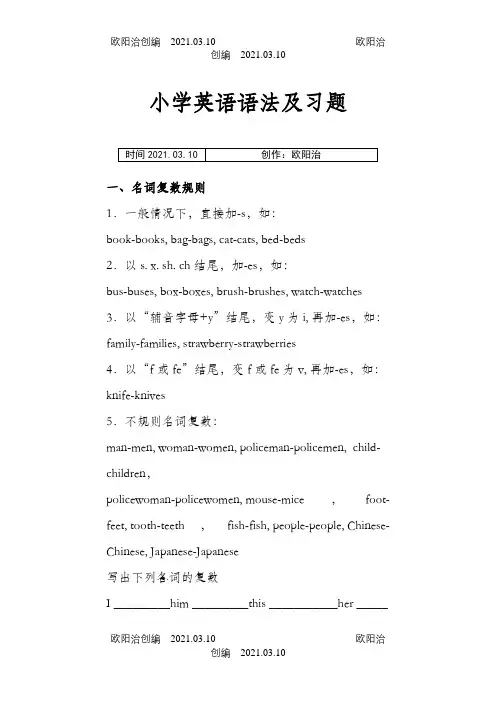
小学英语语法及习题一、名词复数规则1.一般情况下,直接加-s,如:book-books, bag-bags, cat-cats, bed-beds2.以s. x. sh. ch结尾,加-es,如:bus-buses, box-boxes, brush-brushes, watch-watches 3.以“辅音字母+y”结尾,变y为i, 再加-es,如:family-families, strawberry-strawberries4.以“f或fe”结尾,变f或fe为v, 再加-es,如:knife-knives5.不规则名词复数:man-men, woman-women, policeman-policemen, child-children,policewoman-policewomen, mouse-mice ,foot-feet, tooth-teeth,fish-fish, people-people, Chinese-Chinese, Japanese-Japanese写出下列各词的复数I _________him _________this ___________her ______sand_____watch _______child _______photo ________diary ____ __day_____ foot________ book_______ dress _______ _tooth_______ man_____sheep ______box_______ thi ef _______ peach______ wich ______ woman_______ paper_______ juice___________ water_______milk ________ rice__________ tea__________ strawberry ________二、一般现在时(一)一般现在时基本用法介绍1、表示事物或人物的特征、状态。
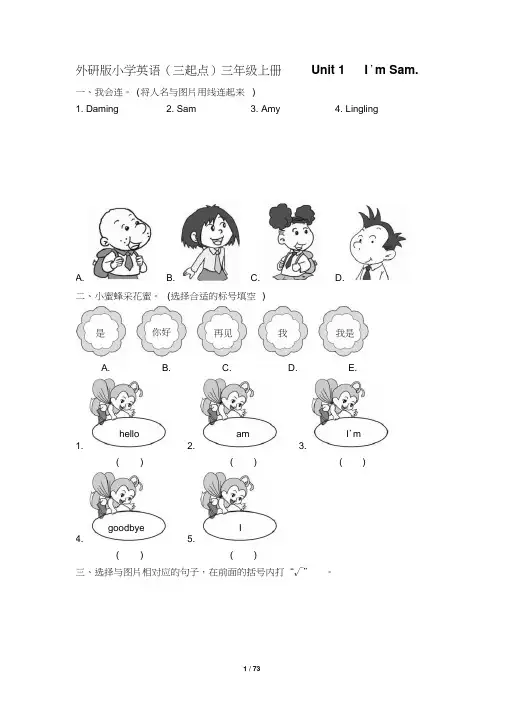
外研版小学英语(三起点)三年级上册Unit 1 I ’m Sam.一、我会连。
(将人名与图片用线连起来)1. Daming2. Sam3. Amy4. LinglingA. B. C. D.二、小蜜蜂采花蜜。
(选择合适的标号填空)是你好再见我我是A. B. C. D. E.hello am I’m1. 2. 3.( ) ( ) ( )goodbye I4. 5.( ) ( )三、选择与图片相对应的句子,在前面的括号内打“√”。
1. ( ) A. I ’m Amy.( ) B. I ’m Lingling.2. ( ) A. I am Daming.( ) B. I am Sam.3. ( ) A. Hello, Lingling.( ) B. Bye- bye.4. ( ) A. Goodbye.( ) B. I ’m Amy.四、情景交际。
( ) 1. 当你遇到Lingling 时,你应该说:A. Hello, I ’m Lingling.B. Hello, Lingling. ( ) 2. 当Tom 向别人介绍自己时应说:A. Hello, I am Tom.B. Hello, Tom. ( ) 3. 放学时老师会对你说:A. Hi.B. Bye-bye.( ) 4. 班内新转来的同学自我介绍叫Amy ,你应该对她说:A. Hello, Amy.B. Hello, I ’m Amy.五、读一读,连一连。
1.2.3.4. A.B.C.D.答案:一、1. D 2. A 3. C 4. B二、1. B 2. A 3. E 4. C 5. D三、1. B 2. A 3. A 4. A四、1. B3. B 2. A4. A点拨:自我介绍时一般用I’m ...五、1. C 点拨:Hello... 的答语是Hello... 或Hi...。
根据人名可知选C。
2. D3. A4. BUnit 2 How are you?一、每组中有一只小猫排错了队,请你把它找出来。
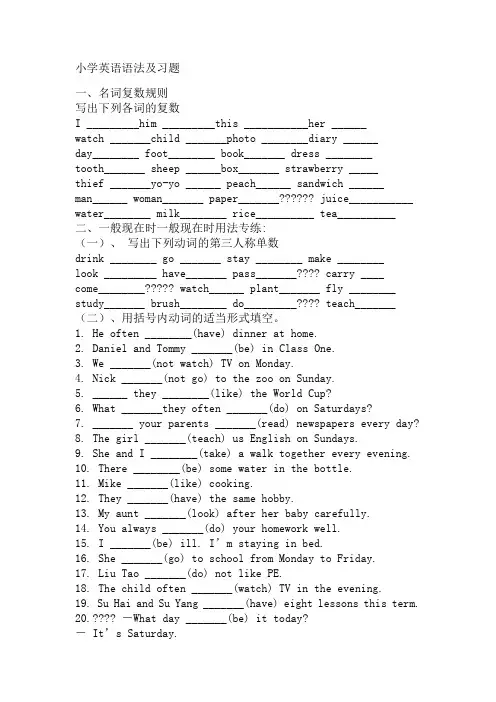
小学英语语法及习题一、名词复数规则写出下列各词的复数I _________him _________this ___________her ______watch _______child _______photo ________diary ______day________ foot________ book_______ dress ________tooth_______ sheep ______box_______ strawberry _____thief _______yo-yo ______ peach______ sandwich ______man______ woman_______ paper_______?????? juice___________ water________ milk________ rice__________ tea__________二、一般现在时一般现在时用法专练:(一)、写出下列动词的第三人称单数drink ________ go _______ stay ________ make ________look _________ have_______ pass_______???? carry ____come________????? watch______ plant_______ fly ________ study_______ brush________ do_________???? teach_______ (二)、用括号内动词的适当形式填空。
1. He often ________(have) dinner at home.2. Daniel and Tommy _______(be) in Class One.3. We _______(not watch) TV on Monday.4. Nick _______(not go) to the zoo on Sunday.5. ______ they ________(like) the World Cup?6. What _______they often _______(do) on Saturdays?7. _______ your parents _______(read) newspapers every day?8. The girl _______(teach) us English on Sundays.9. She and I ________(take) a walk together every evening.10. There ________(be) some water in the bottle.11. Mike _______(like) cooking.12. They _______(have) the same hobby.13. My aunt _______(look) after her baby carefully.14. You always _______(do) your homework well.15. I _______(be) ill. I’m staying in bed.16. She _______(go) to school from Monday to Friday.17. Liu Tao _______(do) not like PE.18. The child often _______(watch) TV in the evening.19. Su Hai and Su Yang _______(have) eight lessons this term.20.???? -What day _______(be) it today?-It’s Saturday.(三)、按照要求改写句子1. Daniel watches TV every evening.(改为否定句)___________________________________________________2. I do my homework every day.(改为一般疑问句,作否定回答) ________________________________________________________3. She likes milk.(改为一般疑问句,作肯定回答)___________________________4. Amy likes playing computer games.(改为一般疑问句,作否定回答)___________________________________________________5. We go to school every morning.(改为否定句)_______________________________________________________6. He speaks English very well.(改为否定句)___________________________________________________7. I like taking photos in the park.(对划线部分提问)________________________________________________________ 8. John comes from Canada.(对划线部分提问)___________________________________________________9. She is always a good student.(改为一般疑问句,作否定回答) ________________________________________________________ 10. Simon and Daniel like going skating.(改为否定句)___________________________________________________(四)、改错(划出错误的地方,将正确的写在横线上)1. Is???? your brother speak English?????????__________________2. Does he likes going fishing????????????? __________________3. He likes play games after class.???????? __________________4. Mr. Wu teachs us English.??????????????? __________________5. She don’t do her homework on Sundays. _________________三、现在进行时(一)、写出下列动词的现在分词:play________ run__________ swim _________make__________go_________ like________???? write________ _ski___________ read________ have_________ sing???? ________ dance_________ put_________ see________ buy _________ love____________ live_______ take_________ come ________???? get_________ stop_________ sit ________ begin________ shop___________ (二)、用所给的动词的正确形式填空:1.The boy __________________ ( draw)a picture now.2. Listen .Some girls _______________ ( sing)in the classroom .3. My mother _________________ ( cook )some nice food???? now.4. What _____ you ______ ( do ) now?5. Look . They _______________( have) an English lesson .6.They ____________(not ,water) the flowers now.7.Look! the girls ________________(dance )in the classroom .8.What is our granddaughter doing? She _________(listen ) to music.???? 9. It’s???? 5???? o’clock now. We_____________(have)supper now10.______Helen____________(wash )clothes? Yes ,she is . (三)、句型转换:1. They are doing housework .(分别改成一般疑问句和否定句)___________________________________________________________ ___________________________________________________________ 2.The students are cleaning the classroom . ( 改一般疑问句并作肯定和否定回答)___________________________________________________________ ___________________________________________________________ 3.I’m playing the football in the playground .(对划线部分进行提问)___________________________________________________________ 4.Tom is reading books in his study . (对划线部分进行提问) 四、将来时练习:填空。
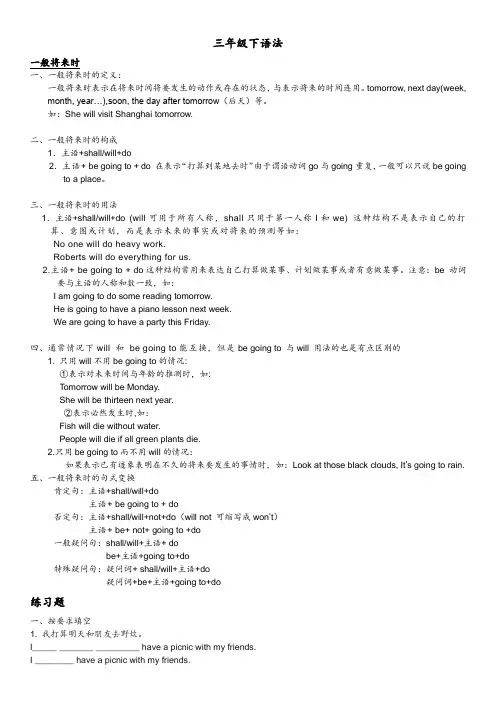
三年级下语法一般将来时一、一般将来时的定义:一般将来时表示在将来时间将要发生的动作或存在的状态,与表示将来的时间连用。
tomorrow, next day(week, month, year…),soon, the day after tomorrow(后天)等。
如:She will visit Shanghai tomorrow.二、一般将来时的构成1.主语+shall/will+do2. 主语+ be going to + do 在表示“打算到某地去时”由于谓语动词go与going重复,一般可以只说be goingto a place。
三、一般将来时的用法1.主语+shall/will+do (will可用于所有人称,shall只用于第一人称I和we) 这种结构不是表示自己的打算、意图或计划,而是表示未来的事实或对将来的预测等如:No one will do heavy work.Roberts will do everything for us.2.主语+ be going to + do这种结构常用来表达自己打算做某事、计划做某事或者有意做某事。
注意:be 动词要与主语的人称和数一致,如:I am going to do some reading tomorrow.He is going to have a piano lesson next week.We are going to have a party this Friday.四、通常情况下will 和be going to能互换,但是be going to 与will 用法的也是有点区别的1. 只用will不用be going to的情况:①表示对未来时间与年龄的推测时,如:Tomorrow will be Monday.She will be thirteen next year.②表示必然发生时,如:Fish will die without water.People will die if all green plants die.2.只用be going to而不用will的情况:如果表示已有迹象表明在不久的将来要发生的事情时,如:Look at those black clouds, It’s going to rain.五、一般将来时的句式变换肯定句:主语+shall/will+do主语+ be going to + do否定句:主语+shall/will+not+do(will not 可缩写成won’t)主语+ be+ not+ going to +do一般疑问句:shall/will+主语+ dobe+主语+going to+do特殊疑问句:疑问词+ shall/will+主语+do疑问词+be+主语+going to+do练习题一、按要求填空1. 我打算明天和朋友去野炊。
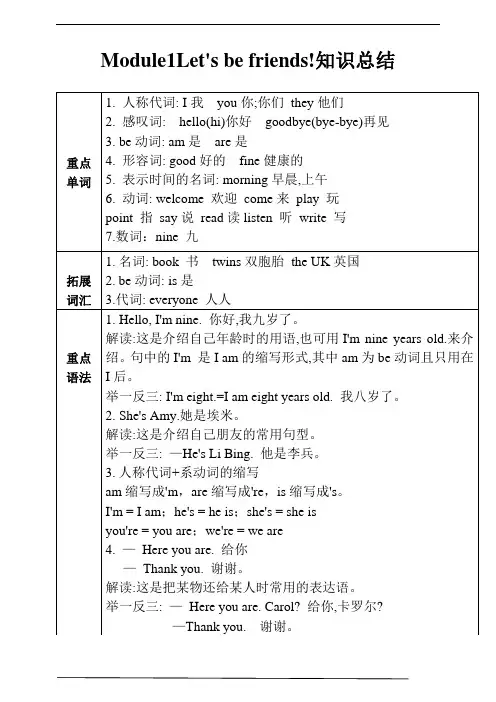
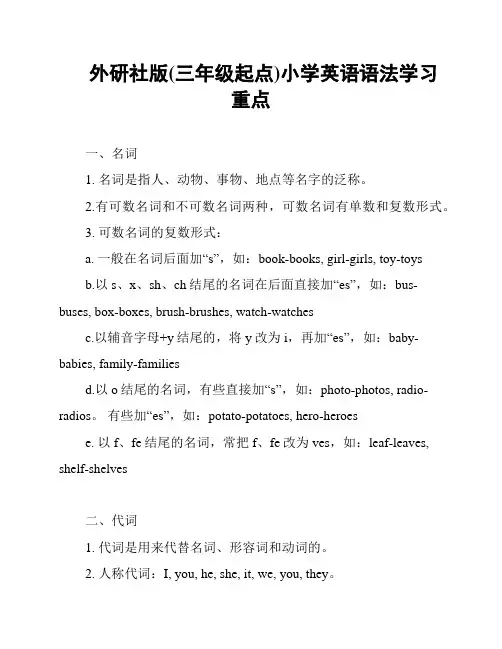
外研社版(三年级起点)小学英语语法学习重点一、名词1. 名词是指人、动物、事物、地点等名字的泛称。
2.有可数名词和不可数名词两种,可数名词有单数和复数形式。
3. 可数名词的复数形式:a. 一般在名词后面加“s”,如:book-books, girl-girls, toy-toysb.以s、x、sh、ch结尾的名词在后面直接加“es”,如:bus-buses, box-boxes, brush-brushes, watch-watchesc.以辅音字母+y结尾的,将y改为i,再加“es”,如:baby-babies, family-familiesd.以o结尾的名词,有些直接加“s”,如:photo-photos, radio-radios。
有些加“es”,如:potato-potatoes, hero-heroese. 以f、fe结尾的名词,常把f、fe改为ves,如:leaf-leaves, shelf-shelves二、代词1. 代词是用来代替名词、形容词和动词的。
2. 人称代词:I, you, he, she, it, we, you, they。
3. 物主代词:my, your, his, her, its, our, your, their。
4. 指示代词:this, that, these, those。
三、动词1. 动词表示动作或状态,及时态和语态。
2. 现在时态:a. 一般现在时,一般在动词原形后面加s,第三人称单数;b. 现在进行时,be动词+现在分词;c. 现在完成时,have/has+过去分词3. 过去时态:a. 一般过去时,动词过去式;b. 过去进行时,was/were+现在分词;c. 过去完成时,had+过去分词。
四、形容词1. 形容词用来描述名词的性质。
2. 形容词的比较级和最高级:a. 有些在形容词后面加-er, -est,如:big-bigger-biggest;b. 有些变形特殊,如:good-better-best。

外研版小学英语(三起点)三年级上册Unit 1 I ’m Sam.一、我会连。
(将人名与图片用线连起来)1. Daming2. Sam3. Amy4. LinglingA. B. C. D.二、小蜜蜂采花蜜。
(选择合适的标号填空)是你好再见我我是A. B. C. D. E.hello am I’m1. 2. 3.( ) ( ) ( )goodbye I4. 5.( ) ( )三、选择与图片相对应的句子,在前面的括号内打“√”。
1. ( ) A. I ’m Amy.( ) B. I ’m Lingling.2. ( ) A. I am Daming.( ) B. I am Sam.3. ( ) A. Hello, Lingling.( ) B. Bye- bye.4. ( ) A. Goodbye.( ) B. I ’m Amy.四、情景交际。
( ) 1. 当你遇到Lingling 时,你应该说:A. Hello, I ’m Lingling.B. Hello, Lingling. ( ) 2. 当Tom 向别人介绍自己时应说:A. Hello, I am Tom.B. Hello, Tom. ( ) 3. 放学时老师会对你说:A. Hi.B. Bye-bye.( ) 4. 班内新转来的同学自我介绍叫Amy ,你应该对她说:A. Hello, Amy.B. Hello, I ’m Amy.五、读一读,连一连。
1.2.3.4. A.B.C.D.答案:一、1. D 2. A 3. C 4. B二、1. B 2. A 3. E 4. C 5. D三、1. B 2. A 3. A 4. A四、1. B3. B 2. A4. A点拨:自我介绍时一般用I’m ...五、1. C 点拨:Hello... 的答语是Hello... 或Hi...。
根据人名可知选C。
2. D3. A4. BUnit 2 How are you?一、每组中有一只小猫排错了队,请你把它找出来。
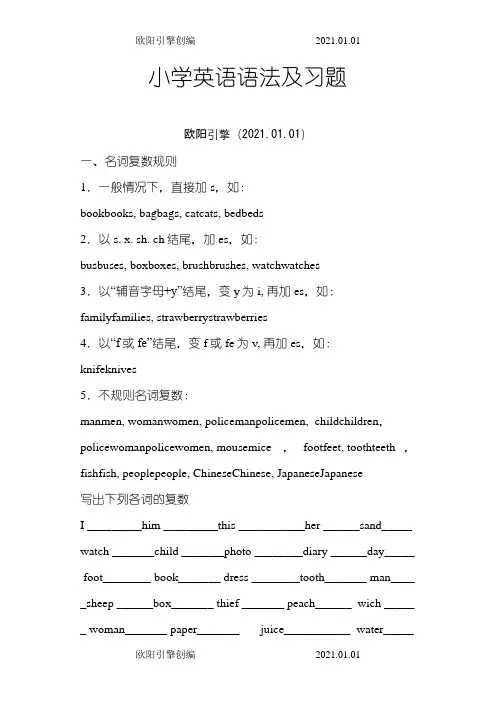
小学英语语法及习题欧阳引擎(2021.01.01)一、名词复数规则1.一般情况下,直接加s,如:bookbooks, bagbags, catcats, bedbeds2.以s. x. sh. ch结尾,加es,如:busbuses, boxboxes, brushbrushes, watchwatches3.以“辅音字母+y”结尾,变y为i, 再加es,如:familyfamilies, strawberrystrawberries4.以“f或fe”结尾,变f或fe为v, 再加es,如:knifeknives5.不规则名词复数:manmen, womanwomen, policemanpolicemen, childchildren,policewomanpolicewomen, mousemice ,footfeet, toothteeth,fishfish, peoplepeople, ChineseChinese, JapaneseJapanese写出下列各词的复数I _________him _________this ___________her ______sand_____ watch _______child _______photo ________diary ______day_____ foot________ book_______ dress ________tooth_______ man____ _sheep ______box_______ thief _______ peach______ wich _____ _ woman_______ paper_______ juice___________ water_______milk________ rice__________ tea__________strawberry ________二、一般现在时(一)一般现在时基本用法介绍1、表示事物或人物的特征、状态。

专项训练:句型一、我会连。
1.Is it a monster?A.My name is Jim. 2.What's that? B.Yes,it is.3.What's your name? C.I'm twelve.4.How old are you? D.It's in the bag.5.Where's the cat? E.Ten.6.How many girls? F.It's a door.7.Here's your present. G.Thank you.8.How are you? H.I'm fine,thank you.二、单项选择。
()1.—________ pens?—Twelve.A.How B.How many C.How old()2.—How old are you,Xiao Hua?—________A.I'm fine. B.I'm nine. C.I ten.()3.—Hello.I'm Yang Li.—Hi. ________A.I am five. B.What's your name? C.I'm Li Hua. ()4.Point________ the desk.A.two B.to C.too()5.—What's that?—________A.It a chair. B.It's a chair. C.That a chair.()6.—Is this your father?—________A.Yes,it isn't. B.Yes,it is. C.No,it is.()7.It's ________ apple.A.a B.am C.an()8.—How are you?—________A.I'm fine,thank you. B.I'm nine. C.I'm nine,too.()9.—________?—Two.A.How many pupil B.How many pupils C.How pupils()10.I________ your new teacher.A.is B.am C.are()11.This is Sam.It is________ dog.A.you B.his C.she()12.—Is it a cat?—________A.Yes,it is a dog. B.No,it isn't. C.No,it is a cat.三、我能根据汉语补全英语句子。

外研版新标准小学英语三年级起点第三册module1单词选解释()第1题. 单词:besideA. prep. 在…旁边B. adj.仁慈的;好心肠的C. (a. m. ) n. 午前,上午D. n. 紫色a. 紫色的()第2题. 单词:leftA. n. 火箭B. conj. 因为;随着prep. 作为,当做C. adj. 熟练的;巧妙的;技术好的 =skillful.D. a. 左边的ad. 向左n. 左,左边()第3题. 单词:stationA. adj. 有趣的;娱乐性的;令人愉快的 n. 招待;款待动词entertain的现在分词.B. adv.特别地;专门地;特意地;格外地C. 与…相像D. n. 车站;电台()第4题. 单词:trainA. n. 事故,意外的事B. n. 火车v. 培训,训练C. 入睡D. n.管子;管状物;地铁;电视;管状器官;v.提供或装上管子()第5题. 单词:rightA. n.理发师vi.当理发师vt.给…理发;修剪B. n.海啸C. 应该,最好还是D. n. 正当的要求;权利;右边;对;正确;公正a. 对;正确的;右;右边的;正当的;妥当的;正常的;健康的ad. 正确地;恰恰;完全地;向右()第6题. 单词:streetA. n. 街,街道B. adj.节俭的;兴旺的;茁壮的C. n. 家庭作业D. n. 门把手()第7题. 单词:excuse meA. 对不起,劳驾B. 运动神经元疾病C. n. 木匠 v. 做木工活D. n. 加法机;算术计算机()第8题. 单词:straightA. a. 一直的,直的ad. 一直地,直地B. 直到……才C. adv. 离开;远离D. adv.不是…就是…,…或…,要么…要么…()第9题. 单词:hillA. n.和服;和服式女晨衣B. n. 小山;丘陵;土堆;斜坡C. adj. 生锈的,腐蚀的;铁锈色的,锈色的;迟钝的D. n. 缺点;退税;退款;不利条件;弊()第10题. 单词:nearA. a. 近的ad. 附近,邻近prep. 在…附近,靠近B. adv. 自船上落下;在船外C. n.青蛙;〈侮辱〉青蛙佬,对法国人的蔑称;[交]铁路辙叉;饰扣,挂环D. n.系列,连续;串联;(广播或电视上题材或角色相同的)系列节目;级数外研版新标准小学英语三年级起点第三册module2单词选解释()第1题. 单词:pictureA. n. (意大利语)先生B. 头痛C. n. 图片,画片,照片D. n.化石;食古不化的人;守旧的事物()第2题. 单词:readA. n. 餐厅B. v. 读;朗读(过去式:read,过去分词:read)C. 在周末D. 去爬山()第3题. 单词:talk toA. n. 工具,器具B. adj.支持的;次要的;辅助性的动词support的现在分词.C. 责备;与…谈话D. n. 法国()第4题. 单词:take picturesA. n. 剩余物;其余的人;[数]余数 vt. 廉价出售B. n.&vt 利用,使用,应用C. v. 照相D. n.湿度;湿气()第5题. 单词:talkA. n. 年龄;时代B. v. 预言;预报;预知;预测C. n. 电筒光D. n.&v. 谈话,讲话,演讲;交谈()第6题. 单词:theseA. v. 误解;误会;不了解B. a. 足够的;充分的adv. 足够地;充分地C. a.&pron. 这些D. n. 泰国()第7题. 单词:runningA. n. 跑步;运转;赛跑;流出B. 至少C. vi.合作;协力;配合D. vt.胁迫;威胁;恐吓()第8题. 单词:listenA. vi. 听B. vt. 免除;豁免adj. 被免除的;被豁免的n. 免税者;被免除义务者C. 为…而献身;急需(某物)D. n. 道歉;辩解;勉强的代用品()第9题. 单词:listen toA. 听B. a. 物理的;身体的C. n.相对性;相对论D. 垃圾箱()第10题. 单词:ChinaA. n. 中国B. (使)干涸;(使)枯竭;讲不出话来C. n.午餐时间;午休时间D. n. 千克;千米外研版新标准小学英语三年级起点第三册Module3单词选解释()第1题. 单词:drinkA. 作为……而出名;被称为……;叫作……B. adv.立刻;马上;就在此刻C. n. 女朋友D. v.喝;饮 n.饮料;酒;喝酒()第2题. 单词:soya milkA. n. 假期B. n.干扰;妨碍C. n.小病;不舒服;厌恶D. 豆奶,豆浆()第3题. 单词:get onA. 上车;相处;进展B. n. 坚果壳;小容器;简明扼要C. n. 光泽;光彩;阳光;晴天;光(亮)v. 发光;照耀;杰出;擦亮D. n.艺术形式()第4题. 单词:chessA. 京剧B. n. (美)秋季;瀑布vi. 落(下),降落;倒下;跌(下);倒塌(过去式fell)C. n. 象棋,国际象棋D. a. 两方任一方的;二者之一conj. 二者之一;要么…ad. (用于否定句或短语后)也()第5题. 单词:kidA. n.大量B. adj.帝国的;皇帝的;特大的;英制的;n.皇帝;女皇;马车车顶;特大号C. n. 小孩v. 开玩笑,欺骗D. n.愤怒;怒火;vt.激怒;vi.发火()第6题. 单词:interestingA. a. 有趣的;有意思的B. n. 代用品;代替者;替补队员 vt. 代替;用 ... 代替;代以C. n. 机会D. n.最大量;最大限度;最高点adj.最高的;最大极限的()第7题. 单词:peopleA. n. 揶揄者;戏弄 v. 欺负;嘲弄B. n. 人,人们;人民;民族C. 插嘴;干预;突然插到…前面;允许加入D. 突然遭遇(风暴等)()第8题. 单词:canA. adj. 不同的;多种多样的B. modal v. 可能;能够;可以n. (美)罐头;罐子C. 有D. n. 决心;测定;规定;(正式)决定;定位()第9题. 单词:play chessA. adj.关闭着的,封闭着的;密闭着的,保密的;准备好了的,定了契约的;v.“close”的过去式和过去分词B. 忍受;容忍C. n. 方式;态度;(pl. ) 礼貌D. 下棋()第10题. 单词:jumpA. n. 蜘蛛B. n. 跳跃;跳v. 跳跃;惊起;猛扑C. a. 意大利(人)的;意大利语的n. 意大利人;意大利语D. 害怕...外研版新标准小学英语三年级起点第三册Module4单词选解释()第1题. 单词:helpA. n. 烟囱B. 向...求助C. a. 昂贵的D. n.&vt. 帮助,帮忙,救命()第2题. 单词:how muchA. 多少钱B. n. 包裹C. n. 副产品D. adv.毫不费力地;轻易地()第3题. 单词:eggA. adj.著名的;卓越的B. n. 蛋;卵C. adj. 巨大的;异常的,非常的D. 给…量尺寸以便做…;适于,适合()第4题. 单词:iceA. a. 坚固的;坚定的n. 公司;企业B. n.耳机;听筒C. n. 包裹,包,捆vt. 包装D. n. 冰;冰块()第5题. 单词:alsoA. ad. 也,同样;而且,还B. adv.逐渐地;越来越多地C. pron. 他(宾格)D. 一会见()第6题. 单词:wantA. vt. 想,想要;需要,必要B. ad. 到处;无论哪里C. a. 不清楚的,微弱的v. 昏晕;昏倒D. a. 镇静的;沉着的v. (使)镇静;(使)沉着()第7题. 单词:juiceA. n. 汁、液B. n. 磁带v. 用磁带录音C. n.力量;优点,长处;(光、声、色等的)力度;人力[数]D. n. 种类;类别;范畴()第8题. 单词:potatoA. n. 土豆,马铃薯B. n. 喷气式飞机;喷口;喷射;喷气式发动机 v. 喷射;喷出;搭乘喷射式飞机C. n.东南,东南方,(美国)东南部;东南地区;adv.在东南;从东南;向东南;来自东南adj.东南的;向东南的;位于东南的;东南部的D. vi. 死亡;凋零;熄灭vt. 死,死于…()第9题. 单词:buyA. 水果派B. n. 拳头 vt. 紧握;用拳头打C. n.收益动词proceed的第三人称一般现在时形式.D. vt. 买()第10题. 单词:flowerA. n. 银B. n.转变;换算C. n. 花D. 出生时外研版新标准小学英语三年级起点第三册Module5单词选解释()第1题. 单词:runA. n. 布丁B. vi. 跑,奔跑;流;流动;运转;(颜色)褪色vt. 经营;管理v. (戏剧,电影等)连演,连映C. adj.过分装饰的;谨慎的;挑剔的;唠叨的,抱怨的D. n. 从商店采买的东西()第2题. 单词:fastA. n. 紧抱,拥抱v. 拥抱,紧抱B. v. 忘记C. a. 快的,迅速的;紧密的ad. 快地,迅速地;紧密地D. n. 蛋;卵()第3题. 单词:skyA. n. 天;天空B. n. 饺子C. adj.全部的;完整的;全面的D. 出生于()第4题. 单词:highA. v. 嘲笑,冷笑n. 嘲笑,冷笑B. a. 高的;高度的ad. 高地C. ad. 也,同样;而且,还D. n.鲶鱼()第5题. 单词:winnerA. n. 贸易vt. 用…进行交换B. n. 获胜者C. vt. 制造,做;使得n. 制造D. n. 女衬衣v. 宽松下垂()第6题. 单词:farA. a.&ad. 远的;远地adv. 很,极,太B. 以 ... 自豪C. n.鼻口部;猪嘴;鼻状物D. n. 土豆,马铃薯()第7题. 单词:afraidA. n. 快餐B. a. 害怕的C. v. 服从,听从D. v.感冒;中寒()第8题. 单词:strongA. n.无知;愚昧B. adv.傲慢地;自大地;得意洋洋地C. a. 强(壮)的;坚固的;强烈的;坚强的;强有力的D. n. 花()第9题. 单词:starA. n.船舱;机舱;小木屋vt.抑制vi.住在小屋B. n. 星,恒星v. 担任主角;主演C. vt. 买D. 代替;而不是()第10题. 单词:wantA. 把垃圾带出去B. vt. 想,想要;需要,必要C. n. 隧道D. 二十七参考答案:Module1: 1-5:ADDBD 6-10:AAABA Module2: 1-5:CBCCD 6-10:CAAAA Module3: 1-5:DDACC 6-10:ABBDB Module4: 1-5:BABDA 6-10:AAADC Module5: 1-5:BCABB 6-10:ABCBB。
小学英语语法及习题一、名词复数规则1.一般情况下,直接加-s,如:book-books, bag-bags, cat-cats, bed-beds2.以s. x. sh. ch结尾,加-es,如:bus-buses, box-boxes, brush-brushes, watch-watches3.以“辅音字母+y”结尾,变y为i, 再加-es,如:family-families, strawberry-strawberries4.以“f或fe”结尾,变f或fe为v, 再加-es,如:knife-knives5.不规则名词复数:man-men, woman-women, policeman-policemen, child-children,policewoman-policewomen, mouse-mice ,foot-feet, tooth-teeth,fish-fish, people-people, Chinese-Chinese, Japanese-Japanese写出下列各词的复数I _________him _________this ___________her ______sand_____ watch _______child _______photo ________diary ______day_____ foot________ book_______ dress ________tooth_______ man_____ sheep ______box_______ thief _______ peach______ wich ______ woman_______ paper_______ juice___________ water_______ milk________ rice__________ tea__________ strawberry ________ 二、一般现在时(一)一般现在时基本用法介绍1、表示事物或人物的特征、状态。
小学英语语法及习题一、名词复数规则1.一般情况下,直接加s,如:bookbooks, bagbags, catcats, bedbeds2.以s. x. sh. ch结尾,加es,如:busbuses, boxboxes, brushbrushes, watchwatches3.以“辅音字母+y”结尾,变y为i, 再加es,如:familyfamilies, strawberrystrawberries4.以“f或fe”结尾,变f或fe为v, 再加es,如:knifeknives5.不规则名词复数:manmen, womanwomen, policemanpolicemen, childchild ren,policewomanpolicewomen, mousemice ,footfeet, toothteeth,fishfish, peoplepeople, ChineseChinese, JapaneseJapanese写出下列各词的复数I _________him _________this ___________her ______ sand_____watch _______child _______photo ________diary _____ _day_____ foot________ book_______ dress ________to oth_______ man_____sheep ______box_______ thief __ _____ peach______ wich ______ woman_______ paper _______ juice___________ water_______milk_____ ___ rice__________ tea__________strawberry ________二、一般现在时(一)一般现在时基本用法介绍1、表示事物或人物的特征、状态。
外研版小学英语(三起点)三年级上册Unit 1 I ’m Sam.一、我会连。
(将人名与图片用线连起来) 1. Daming 2. Sam3. Amy4. LinglingA.B.C.D.二、小蜜蜂采花蜜。
(选择合适的标号填空)A. B. C. D. E.1.2.3.( ) ( ) ( )4.5.( ) ( )三、选择与图片相对应的句子,在前面的括号内打“√”。
是你好再见 我 我是helloamI ’mgoodbyeI1. () A. I’m Amy.() B. I’m Lingling.2. () A. I am Daming.() B. I am Sam.3. () A. Hello, Lingling.() B. Byebye.4. () A. Goodbye.() B. I’m Amy.四、情景交际。
() 1. 当你遇到Lingling时,你应该说:________A. Hello, I’m Lingling.B. Hello, Lingling. () 2. 当Tom 向别人介绍自己时应说:________A. Hello, I am Tom.B. Hello, Tom. () 3. 放学时老师会对你说:________A. Hi.B. Bye-bye.() 4. 班内新转来的同学自我介绍叫Amy,你应该对她说:________A. Hello, Amy.B. Hello, I’m Amy.五、读一读,连一连。
1. A.2. B.3. C.4. D.答案:一、1. D 2. A 3. C 4. B二、1. B 2. A 3. E 4. C 5. D三、1. B 2. A 3. A 4. A四、1. B 2. A点拨:自我介绍时一般用I’m ...3. B4. A五、1. C点拨:Hello...的答语是Hello...或Hi...。
根据人名可知选C。
2. D3. A4. BUnit 2How are you? 一、每组中有一只小猫排错了队,请你把它找出来。
小学英语语法及习题一、名词复数规则写出以下各词的复数I _________him _________this ___________her ______watch _______child _______photo ________diary ______day________ foot________ book_______ dress ________ tooth_______ sheep ______box_______ strawberry _____thief _______yo-yo ______ peach______ sandwich ______ man______ woman_______paper_______juice___________water________ milk________ rice__________ tea__________二、一般此刻时一般此刻时用法专练:(一)、写出以下动词的第三人称单数drink ________ go _______ stay ________ make ________ look _________ have_______ pass_______ carry ____come________ watch______ plant_______ fly ________study_______ brush________ do_________ teach_______(二)、用括号内动词的适合形式填空。
1.He often ________(have) dinner at home.2.Daniel and Tommy _______(be) in Class One.3.We _______(not watch) TV on Monday.4.Nick _______(not go) to the zoo on Sunday.5.______ they ________(like) the World Cup?6.What _______they often _______(do) on Saturdays?7._______ your parents _______(read) newspapers every day?8.The girl _______(teach) us English on Sundays.9.She and I ________(take) a walk together every evening.10.There ________(be) some water in the bottle.11.Mike _______(like) cooking.12.They _______(have) the same hobby.13.My aunt _______(look) after her baby carefully.14.You always _______(do) your homework well.15. I _______(be) ill. I’m staying in bed.16.She _______(go) to school from Monday to Friday.17.Liu Tao _______(do) not like PE.18.The child often _______(watch) TV in the evening.19.Su Hai and Su Yang _______(have) eight lessons this term.20.-What day _______(be) it today?-It ’s Saturday.(三)、依据要求改写句子1.Daniel watches TV every evening.(改为否认句 )___________________________________________________2.I do my homework every day.(改为一般疑问句,作否认回答 ) ________________________________________________________3.She likes milk.(改为一般疑问句,作必然回答)___________________________4. Amy likes playing computer games.(改为一般疑问句,作否认回答 )___________________________________________________5. We go to school every morning.(改为否认句)_______________________________________________________ 6. He speaks English very well.(改为否认句)___________________________________________________7. I like taking photos in the park.(对划线部散发问)________________________________________________________ 8.John comes from Canada.( 对划线部散发问 )___________________________________________________9.She is always a good student.(改为一般疑问句,作否认回答)________________________________________________________ 10. Simon and Daniel like going skating.(改为否认句 )___________________________________________________(四)、改错 ( 划犯错误的地方,将正确的写在横线上 )1.Is your brother speakEnglish?__________________2.Does he likes goingfishing?__________________3.He likes play games afterclass.__________________4.Mr. Wu teachs usEnglish.__________________5.She don ’t do her homework on Sundays. _________________三、此刻进行时(一)、写出以下动词的此刻分词:play________ run__________ swim _________make__________ go_________ like________write_________ski___________read________ have_________ sing________dance_________put_________ see________ buy _________ love____________live_______ take_________ come ________ get_________stop_________ sit ________ begin________ shop___________(二)、用所给的动词的正确形式填空:1.The boy __________________ ( draw)a picture now..2. Listen .Some girls _______________ ( sing)in the classroom3. My mother _________________ ( cook )some nicefood now.4.What _____ you ______ ( do ) now?5.Look . They _______________( have) an English lesson .6.They ____________(not ,water) the flowers now.7.Look! the girls ________________(dance )in the classroom .8.What is our granddaughter doing? She _________(listen )to music.9. It’s5o’clock now. We_____________(have)supper now10.______Helen____________(wash )clothes? Yes ,she is .(三)、句型变换:1. They are doing housework .(分别改成一般疑问句和否认句)___________________________________________________________ ___________________________________________________________ 2.The students are cleaning the classroom . (改一般疑问句并作必然和否认回答)___________________________________________________________ ___________________________________________________________ 3.I’m playing the football in the playground .(对划线部分进行发问)___________________________________________________________ 4.Tom is reading books in his study . (对划线部分进行发问)四、未来时练习:填空。
小学英语语法及习题一、名词复数规则1.一般情况下,直接加-s,如:book-books, bag-bags, cat-cats, bed-beds2.以 s. x. sh. ch 结尾,加 -es,如:bus-buses, box-boxes, brush-brushes, watch-watches3.以“辅音字母+y”结尾,变y 为 i, 再加 -es,如:family-families,strawberry-strawberries4.以“ f 或 fe”结尾,变 f 或 fe 为 v, 再加 -es,如:knife-knives5.不规则名词复数:man-men, woman-women, policeman-policemen, child-children ,policewoman-policewomen, mouse-mice ,foot-feet, tooth-teeth ,fish-fish, people-people, Chinese-Chinese, Japanese-Japanese写出下列各词的复数I _________him _________this ___________her ______sand_____ watch _______child _______photo ________diary ______day_____ foot________ book_______ dress ________tooth_______ man_____ sheep ______box_______ thief _______ peach______ wich ______ woman_______ paper_______juice___________ water_______ milk________ rice__________ tea__________ strawberry ________二、一般现在时(一)一般现在时基本用法介绍1、表示事物或人物的特征、状态。
如: The sky is blue.天空是蓝色的。
2、表示经常性或习惯性的动作。
如: I get up at six every day.我每天六点起床。
3、表示客观现实。
如: The earth goes around the sun.地球绕着太阳转。
(二)一般现在时的构成1、 be 动词:主语 +be(am,is,are)+其它。
如: I am a boy.我是一个男孩。
2、行为动词:主语+行为动词 (+其它 )。
如: We study English.我们学习英语。
当主语为第三人称单数(he, she, it) 时,要在动词后加"-s" 或 "-es" 。
如: Mary likes Chinese. 玛丽喜欢汉语。
(三)一般现在时的变化1、 be 动词的变化。
否定句:主语 + be + not + 其它。
如: He is not a worker. 他不是工人。
一般疑问句: Be +主语 +其它。
如: -Are you a student? -Yes. I am. / No, I'm not.特殊疑问句:疑问词+一般疑问句。
如: Where is my bike?2、行为动词的变化。
否定句:主语 + don't( doesn't ) + 动词原形 (+ 其它 )。
如: I don't like bread.当主语为第三人称单数时,要用doesn't 构成否定句。
如: He doesn't often play.一般疑问句: Do( Does ) + 主语 +动词原形 +其它。
如:Do you often play football? - Yes, I do. / No, I don't.当主语为第三人称单数时,要用does 构成一般疑问句。
如:Does she go to work by bike? Yes, she does. / No, she doesn't.4 、特殊疑问句:疑问词+一般疑问句。
如: How does your father go to work?5、动词 +s 的变化规则(1)一般情况下,直接加 -s,如: cook-cooks, milk-milks(2)以 s. x. sh. ch. o 结尾,加 -es,如: guess-guesses, wash-washes, watch-watches, go-goes( 3)以“辅音字母+y ”结尾,变y 为 i, 再加 -es,如: study-studies(四)一般现在时用法专练:1、写出下列动词的第三人称单数drink ________ go _______ stay ________ make ________look _________ have_______ pass_______carry _______ come________ watch______ plant_______ fly ________ study_______ brush________ do_________teach_______ drink______start_______2、用括号内动词的适当形式填空。
1.He often ________(have) dinner at home.2.Daniel and Tommy _______(be) in Class One.3.We _______(not watch) TV on Monday.4.Nick _______(not go) to the zoo on Sunday.5.______ they ________(like) the World Cup?6.What _______they often _______(do) on Saturdays?7._______ your parents _______(read) newspapers every day?8.The girl _______(teach) us English on Sundays.9.She and I ________(take) a walk together every evening.10.There ________(be) some water in the bottle.11.Mike _______(like) cooking.12.They _______(have) the same hobby.13.My aunt _______(look) after her baby carefully.14.You always _______(do) your homework well.15.I _______(be) ill. I ’m staying in bed.16.She _______(go) to school from Monday to Friday.17.Liu Tao _______(do) not like PE.18.The child often _______(watch) TV in the evening.19.Su Hai and Su Yang _______(have) eight lessons this term.20.What day _______(be) it today? - It’ s Saturday.3、改错 (划出错误的地方,将正确的写在横线上)1.Is your brother speak English?__________________2.Does he likes going fishing?__________________3.He likes play games after class.__________________4.Mr. Wu teach us English._____________________5.She dont do her homework on Sundays. _________________三、现在进行时(一)现在进行时基本用法介绍1、现在进行时表示现在正在进行或发生的动作,也可表示当前一段时间内的活动或现阶段正在进行的动作。
2、现在进行时的肯定句基本结构为be+动词 ing.如: I am watching TV .3、现在进行时的否定句在be 后加 not。
如: I am not watching TV .4、现在进行时的一般疑问句把be 动词调到句首。
如: Are you watching TV ?5.现在进行时的特殊疑问的基本结构为:疑问词 + be + 主语 + 动词 ing?What are you doing?但疑问词当主语时其结构为:疑问词 + be + 动词 ing? 如: Who is singing there?(二)动词加ing 的变化规则1.一般情况下,直接加ing ,如: cook-cooking2.以不发音的 e 结尾,去 e 加 ing ,如: make-making, taste-tasting3.如果末尾是一个元音字母和一个辅音字母,双写末尾的辅音字母,再加ing,如:停止 stop-stopping游泳swim—swimming坐下sit—sitting 逐渐变成get— getting 跑 run— running放下Put--- putting (三)现在进行时专项练习:1、写出下列动词的现在分词:play________ run__________ swim _________make __________ go_________ like________write________ ski___________read________ have_________ sing________ dance _________ put_________ see________ buy _________ love____________ live_______ take_________ come ________ get _________ stop_________ sit ________2、用所给的动词的正确形式填空:1.The boy __________________ ( draw)a picture now.2.Listen .Some girls _______________ ( sing)in the classroom .3.My mother _________________ ( cook )some nice food now.4.What _____ you ______ ( do ) now?5.Look . They _______________( have) an English lesson .6.They ____________(not ,water) the flowers now.7.Look! the girls ________________(dance )in the classroom .8.What is our granddaughter doing? She ________(listen ) to music.9.It ’s 5 o’ clock now. We _____________(have)supper now10.______Helen____________(wash )clothes? Yes ,she is .四、将来一、概念:表示将要生的作或存在的状及打算、划或准做某事。